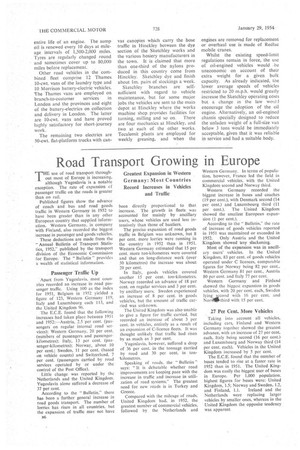Road Transport Growing in Europe
Page 32

If you've noticed an error in this article please click here to report it so we can fix it.
Greatest Expansion in Western Germany: Most Countries Record Increases in Vehicles and Traffic
THE use of road transport throughout most of Europe is increasing, although Yugoslavia is a notable exception. The rate of expansion cf passenger traffic on the roads is greater than on rail.
Published figures show the advance of coach and bus and road goods traffic in Western Germany in 1952 to have been greater than in any other European country that supplied information. Western Germany, in company with Finland. also recorded the biggest increase in passenger and goods vehicles.
These deductions are made from the "Annual Bulletin of Transport Statistics, 1952," published by the transport division of the Economic Commission for Europe. The " Bulletin " provides a wealth of statistical information. Passenger Traffic Up
Apart from Yugoslavia, most countries recorded an increase in road passenger traffic. Using 100 as the index for 1951, Belgium in 1952 yielded a figure of 123, Western Germany 119, Italy and Luxembourg each 113, and the United Kingdom 96.
The E.C.E. found that the following increases had taken place between 1951 and I952:—Austria, 2.5 per cent. (passengers on regular internal road services); Western Germany, 20 per cent. (numbers of passengers and passengerkilometres); Italy, 13 per cent. (passenger-kilometres); Norway, about 10 per cent.; Sweden, 11 per cent. (based on vehicle counts) and Switzerland, 7 per cent. (passengers carried by road services operated by or under the control of the Post Office).
Little change was reported by the Netherlands and the United Kingdom. Yugoslavia alone suffered a decrease of 37 per cent. According to the "Bulletin," there has been a further general increase in road goods transport. The number of lorries has risen in all countries, but the expansion of traffic may not have B6
been directly proportional to that increase. The growth in fleets was accounted for mainly by ancillary users, whose vehicles are used less intensively than those of hauliers.
The precise expansion of road goods traffic in Belgium was unknown, but 8 per cent, more lorries were running in the country in 1952 than in 1951. Western Germany estimated that 15 per cent, more ton-kilometres were covered and that on long-distance work (over 50 kilometres) the increase was about 20 per cent.
In Italy, goods vehicles covered another 15 per cent. ton-kilometres. Norway recorded an advance of 18 per cent. on regular services and 3 per cent. by ancillary users. Sweden experienced an increase of 8 per cent. in goods vehicles, but the amount of traffic carried was unknown.
The United Kingdom was also unable to give a figure for traffic carried, but recorded an increase of about 3 per cent. in vehicles, entirely as a result of an expansion of C-licence fleets. It was thought unlikely that traffic had risen by as much as 3 per cent.
Yugoslavia, however, suffered a drop of 36 per cent. in the tonnage carried by road and 30 per cent. in tonkilometres.
Speaking of roads, the " Bulletin" says: "It is debatable whether road improvements are keeping pace with the increase in traffic and increase in utilization of road systems." The greatest need for new roads is in Turkey and Greece. Compared with the mileage of roads, United Kingdom had. in 1952, the greatest number of commercial vehicles, followed by the Netherlands and
Western Germany. In terms of population, however, France led the field in commercial vehicles, with the United Kingdom second and Norway third.
Western Germany recorded the biggest increase in buses and coaches (19 per cent.), with Denmark second (14 per cent.) and Luxembourg third (11 per cent.). The United Kingdom showed the smallest European expansion (1 per cent.). According to the "Bulletin," the rate of increase of goods vehicles reported in 1951 was maintained or exceeded in
1952. Only Austria and the United Kingdom showed -any .slackening.
Most of the expansion was in ancillary users' vehicles. In the United Kingdom, 83 per cent. of goods vehicles operated under C licences, comparable figures for Norway being 82 per cent.. Western Germany 81 per cent., Austria 80 per cent. and Italy 77 per cent.
Western Germany and Finland showed the biggest expansion in goods vehicles, with 20 per cent. each, Sweden lying_vcond with 16 per cent. and Not:Ai/third with 15 per cent. 27 Per Cent. More Vehicles
Taking into account all vehicles, including cars, Finland and Western Germany together showed the greatest advance, with an increase of 27 per cent. each, Italy being second (16 per cent.) and Luxembourg and Norway third (14 per cent. each). Vehicles in the United Kingdom increased by 5 per cent. The E.C.E. found that the number of buses tended to rise at a faster rate in 1952 than in 1951. The United Kingdom was easily the biggest user of buses in Europe. Per 1,000 population. highest figures for buses were: United Kingdom, 1.5; Norway and Sweden, 1.2, and Finland, 1.1. Ireland and the Netherlands were replacing larger vehicles by smaller ones, whereas in the United Kingdom the opposite tendency was apparent












































































